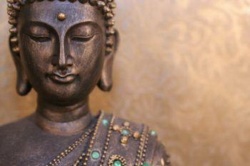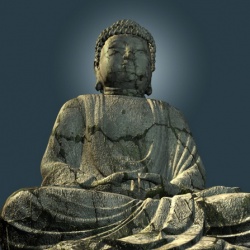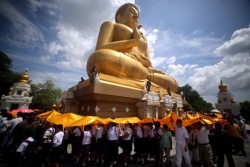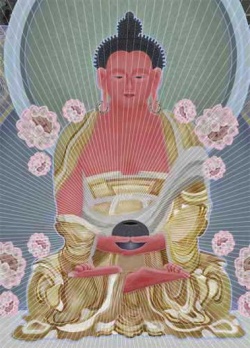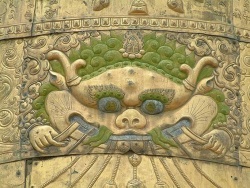The Three Gems Ceremony & Five Lay Precepts By Lotus – Harriet Vu
By Lotus – Harriet Vu
The three gems ceremony is the fundamental ceremony in the practice of Buddhism. The Three Gems ceremony marks the beginning and an affirmation of a journey which ultimately leads to freedom. It is a practice of mental reflection that aids a practitioner’s resolve to embark and persist on the journey of finding the true source of liberation within. For millions of Buddhists around the world, the The Gems Ceremony is not only an initiation ceremony into the practice of Buddhism but also a rite of passage to formally accept the guidance of a Buddhist teacher into the practice of Buddhism.
What are the Three Gems?
The Three Gems was first established when Gotama Buddha, upon enlightenment went to visit his fellow five ascetics who previously had practice self-mortification with him. These ascetics were the first ones the Buddha wanted to tell the truth about liberation to because they had long practiced self-mortification with him without success and endured excruciating physical and mental pain. When he came to them, the first sermon the Buddha delivered was the Four Noble Truths. It was then that the Three Gems of Buddhism came to existence.
They are as follows:
1. The Buddha – Translates as “the Awakened One”, a totally enlightened being who possesses profound intuitive wisdom which transcend dualism and suffering of all beings. A being who is completely free and awakened. In essence, this Buddha does not only exist in the form of the historical teacher Gotama Buddha but also in all of us as the essence of all beings.
2. The Dharma – Teachings from the Buddha, the Awakened One which helps others beings transcend sufferings into peace and liberation. The Dharma of the Buddha has six supreme qualities:
1. Svakkhato (Pali) The Dharma is not a speculative philosophy, but is the Universal Law found through enlightenment and is preached precisely. Therefore it is Excellent in the beginning (Sila — Moral principles), Excellent in the middle (Samadhi — Concentration) and Excellent in the end (Panña — Wisdom).
2. Samditthiko (Pali) The Dharma is testable by practice and known by direct experience.
3. Akaliko (Pali) The Dharma is able to bestow timeless and immediate results here and now, for which there is no need to wait until the future or next existence. 4. Ehipassiko (Pali) The Dharma welcomes all beings to put it to the test and to experience it for themselves.
5. Opaneyiko (Pali) The Dharma is capable of being entered upon and therefore it is worthy to be followed as a part of one's life.
6. Paccattam veditabbo viññunhi (Pali) The Dharma may be perfectly realized only by the noble disciples (Pali: Ariyas) who have matured and who have become enlightened in supreme wisdom.
The Dharma is numerous and depending on the different sects and schools of Buddhism, it can be organized differently to suit different types of practice. The Dharma are compared to good medicine, depending on the person, does the Buddha applies a different formula to cure their illness of ignorant which causes sufferings. In Zen, the Dharma is only taught by a teacher who is authorized by their own teacher to teach, having receiving “Dharma Transmission” from the experiential Zen practice under their teacher’s guidance. Therefore, the Dharma in Zen is not one of intellectual knowledge but of intuitive non-dual wisdom obtained through years of meditative practice. 3. The Sangha – In the east, it denotes a community of Buddhist Monastics who exceeds five in numbers, practicing Buddhism together and living together.
In the West, it loosely denotes a community of Buddhists who practice Buddhism in their own lives and comes together to learn and support each other in their practice. The strengths of community practice is not only transforming but can assists the individual members learn about themselves and others through the support and sharing of their practice. In the Buddha’s time, each year during the rainy season in northern India, the Buddha would gather all his monastic students together into a community, to reside in one place and cease travelling for a period of 3 months. During these three months, the more experienced practitioners would guide and teach the more novice ones and the Buddha himself would provide sermons and guidance to the community during these times. An organization of people dedicated to the reach the goal of the end of suffering. a. Principles of six harmonies
b. Devoted to truth and practice
c. Devoted to learning and spreading the Dharma
The power of group practice helps the practitioner to progress at a faster pace than one can normally do since it encourages one to practice more frequently and learn more. The Sangha is guided by a set of guidelines set by the Buddha called “precepts” for each individual members to strive and abide by. Other than these “precepts” the Sangha is also guided by the “six harmony principles” which the Buddha established to help preserve peace and harmony among the group.
Why do we vow to honour and take refuge in the 3 gems?
Because it means a degree of humility in accepting that we don’t have all the answers that we are accepting the practice to embark on the road towards liberation from sufferings. Our egos have for so many years wanting to not submit to anything, to not accept any guidance or wisdom from anyone. We want to feel special and yet this very feeling of being special or proud is fragile and illusory. Because of the need to be proud and above all, the need to be recognized, we suffer.
The Three Gems Ceremony is about submission and surrendering our lives over to the power of the awakened nature in all of us, to the teacher (Gotama Buddha) who had point out of the condition of sufferings and how to end it. The Three Gems Ceremony is about observance to the Dharma, a set of transformative teachings which are pointers to the truths for over 2,500 years. In taking the vows to dwell in the 3 gems, we vow to be a part of and support the group of individuals who are there with one goal in mind – the practice of liberation. In honouring the awakened teacher (the Buddha), his teachings which guide us (the Dharma) and the community which support us (the Sangha) in our practice, we take the vow to dwell in and honour the Three Gems.
Why do we take the five basic precepts?
The Five Precepts are commitments to abstain from killing, stealing, sexual misconduct, lying and intoxication. Undertaking the five precepts is part of both lay Buddhist initiation and regular lay Buddhist devotional practices. They are not formulated as imperatives, but as training rules that laypeople undertake voluntarily to facilitate practice.
These five precepts form a foundation of ethical practice which helps preserve inner peace when followed. In respecting life, we honour life, our own and others. In not coveting things and possessions, we learn to be non-attached to things which are impermanent. In not engaging in sexual misconduct which can hurt ourselves and others; we learn to honour and respect the feelings of others and of our own. In not speaking of untruths, we learn to abide by the truths and surrender to truths of reality in which we experience to find freedom. In not intoxicating our bodies and use drugs which are harmful to our bodies, we respect the vehicle of life which we dwell in to use it as a vehicle for liberation.
The five lay precepts are the foundations for which we can lay and ground our mediation practice. It serves as an aid to our progress, not a hindrance or something to cling on to as truths. It is a vehicle, an effective vehicle to peace. In my experience I the precepts makes the practice easier and progressively more effective. It is one of the six boats (Paramitas) which takes us across the sea of sufferings to the father’s shore. Therefore, after taking the precepts, we regularly come together every three to six months to affirm our original vows to keep us on track and support each other in our meditation practice.
Other Buddhists in the future may feel they are confident enough and take Ten Zen Precepts, Forty Nine Boddhisattva Precepts etc….but it is entirely up to you. No one will be following you and counting whether you break them or not….or criticizing you. They are nothing more than affirmations to lead a more wholesome life. If you choose not to, no one can force you.
For those who choose to take the Three Gems and the Five Lay Precepts, I congratulate you on your dedication to embark on a journey of finding wholeness. It was a sacred ceremony to me many years ago which I have also taken with my teacher. I didn’t know so much how much it meant, all I knew was that there was this wonderfully peaceful and happy Buddha who I want to be like, this wonderful loving teacher who I respected and wanted to be guided by, and wonderful group of people who I enjoy coming together with to learn of the Dharma and practice it. So everywhere I go, I find the Three Gems to be with. This is how we create peace wherever we go. This is the affirmative powers of accepting the Three Gems.
